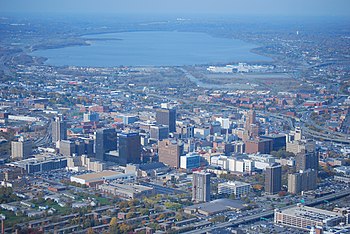Downtown Syracuse
For over a century, it was also the retail and entertainment center of Central New York, with large department stores such as Chappell's, The Addis Co., Flah's, E.W.Edwards, Woolworth's, Grant's, Lincoln Stores, The Mohican, David's, Kresge's, Clark Music Co., Dey Brothers, and Sibley's.By the mid-19th century, the construction of Erie Canal further transformed the busy intersection into the center of commerce and trade in Central New York.These efforts were supported by The National Endowment of the Arts and the State Office of Parks and Recreation, which provided grants to help the restoration continue.The theatre now boasts having prominent performers, such as Jerry Seinfeld and Celtic Women, bringing their acts to Syracuse and often features many popular Broadway shows.Today, downtown Syracuse is an economic center, with many insurance companies, banks, and law firms having a large presence there.Since the late 1980s, downtown Syracuse has also increasingly become a nightlife center, with many bars, clubs, restaurants, and pubs located in the Armory Square area.




Syracuse, New YorkCentral New YorkneighborhoodsPopulationMedian household incomeOwner-occupiedZIP codesErie CanalChappell'sWoolworthsuburbanSyracusePeter MuserliancobblestoneClinton SquareHanover SquareArmory SquareForman ParkHanover Square, SyracuseSyracuse'snightlifeOktoberfestMarriott Syracuse DowntownNational Register of Historic PlacesAmos BlockArmory Square Historic DistrictCentral New York Telephone and Telegraph BuildingCentral Technical High SchoolGere Bank BuildingGridley BuildingHanover Square Historic DistrictHotel SyracuseLoew's State TheaterMontgomery Street-Columbus Circle Historic DistrictNew York Central Railroad Passenger and Freight StationNiagara Hudson BuildingOnondaga County War MemorialPlymouth Congregational ChurchSt. Paul's Cathedral and Parish HouseC.W. Snow and Company WarehouseSouth Salina Street Downtown Historic DistrictSyracuse City HallSyracuse Savings BankThird National BankWeighlock BuildingWhite Memorial BuildingHamilton White HouseSyracuse UniversityNancy CantorThe WarehouseList of tallest buildings in Syracuse, New YorkSyracuse HeraldNational Park ServiceBrightonElmwoodEastwoodFar WestsideTipperary HillLakefrontFranklin SquareInner HarborLincoln HillMeadowbrookNear EastsideNear NortheastHawley–GreenLittle ItalyNear WestsideNorth ValleyNorthsideOuter ComstockSalt SpringsSedgwickSkytopSkunk CitySouth ValleySouthwestStrathmoreUniversity HillMarshall StreetUniversity NeighborhoodWestcottWestsideWashington SquareMetropolitan areaOnondaga LakeOnondaga CountyFinger LakesUpstate New YorkHistoryOnondaga NationGreat PeacemakerHiawathaSainte MarieSimon Le MoyneEthnic groupsHistoric placesMayorsNotable citizensJohn WilkinsonSamuel Joseph MayMatilda Joslyn GageLouis MarshallRailroadsSyracuse stationOnTrackUnderground RailroadairportTransportation Center/Amtrak train stationInterstate highwaysAir National GuardBristol Myers SquibbCarrier GlobalDestiny USAColumbus CircleLockheed MartinNational GridO'Brien & GereTurning Stone Resort CasinoRaymour & FlaniganSeneca DataWegmansBryant & Stratton CollegeEmpire State UniversityLe Moyne CollegeOnondaga Community College